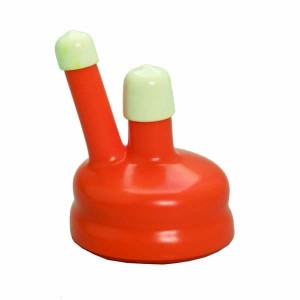I wanted to expand a bit on what I wrote in my Basic Mead Recipe about the next steps in meadmaking, once primary fermentation is finished.
I generally brew 3 gallon batches, and once it’s brewed it generally will bubble steadily for 2-4 weeks, and then will take another week or three to completely stop bubbling. In addition, you will see an inch or three (depending on ingredients) of sediment at the bottom of the carboy. At this point, primary fermentation is finished. You can either leave it in the carboy until you are ready to bottle, but I generally don’t. Some argue that the mead will pick up off-flavors from being with the sediment, but my real motivation is to try my latest batch of mead right away!
I like to siphon the clear mead off the top of the sediment, into one-gallon jugs, for further aging/clarifying. I can always get 2 gallons of clear mead from each batch, and once they are in the jugs I put airlocks on them for further aging. This process, of siphoning fermentations from one carboy into another container, is called “racking.”
I never could get the knack of siphoning well, until I started using a carboy cap like this one:

This elegantly simple device allows you to easily siphon every time. Simply put a plastic hose or rod through the center, larger diameter hole so that it goes down into the mead below the top surface of the liquid, but above the sediment layer, and put the other end of the hose into the 1-gallon jug. Then simply blow air into the other, taller hole. The air pressure will force the mead up through the hose and into your other container. As soon as the liquid makes it into the smaller jug, you’ve started the siphon and it will go by itself.
In addition, I can usually get additional clear mead, and most often I drink it right away. This gives me a great idea of how the mead turned out. It’s nearly always delicious right off the bat (some batches are of course better than others), though each batch will definitely improve with age. When I first started making mead, I would drink pretty much all of the mead right away. Now that I generally have several batches going at a time, I am finally able to get some as far as bottling so that it actually can age. So nowadays I nearly always put back 2 gallons of clear mead for further aging, and drink whatever additional clear mead that I can get from the carboy.
What you are left with in the bottom of the carboy, ie, the sediment and some additional liquid, I have taken to call “plonk.” I got this term from Harper Meader but I think we might use it a bit differently. I keep a half-gallon plonk jar in the fridge, and all the plonk from all the batches goes into this jar. This is usually very thick with all the sediment, so I don’t usually drink it. Many meadmaking resources will tell you to throw this away, but I completely disagree: plonk is fabulous for cooking!
My favorite use for plonk is either as a marinade, or poured over meat of some sort that is either roasting, crock-potting, or simmering in a skillet. Let it cook down a bit (until the alcohol evaporates) and it’s a delicious additive. So far my favorite use of plonk was the sediment from my cacao mead (made before I started keeping a vigilant log here), poured over sauteed pork tenderloin medallions with veggies. Yum!
Another reason I like to keep the plonk: nutrition! There are a ton of nutrients there, between the dead yeast (proteins) and other compounds synthesized during fermentation (such as B-complex vitamins). You can learn more about the nutrients involved in fermentation in Stephen Harrod Buhner’s book Sacred And Herbal Healing Beers, and there is also a good summary of Buhner’s work in this article.
